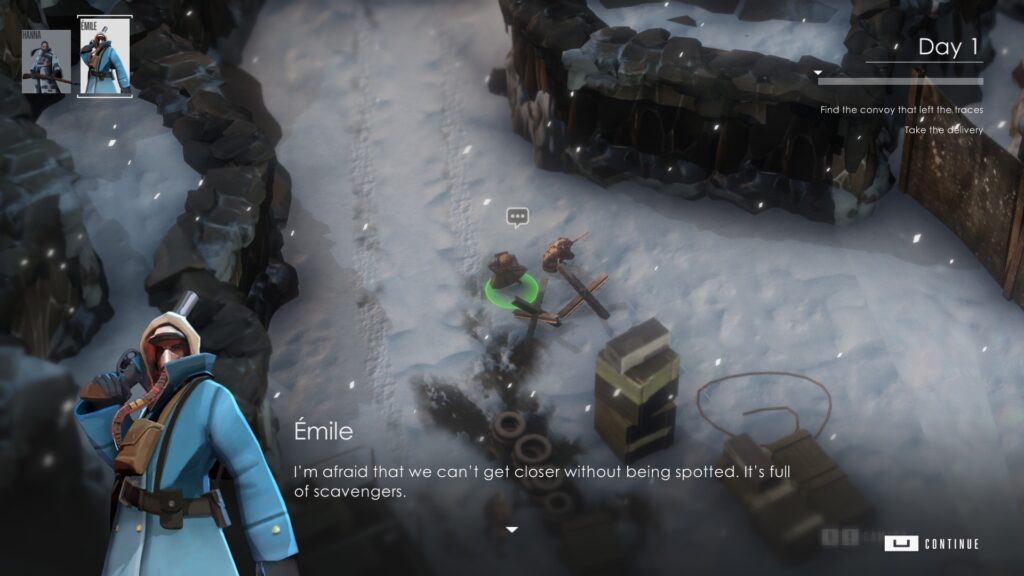
Developer: RecoTechnology
Publisher: RecoTechnology
Platform: PC, Xbox One, PS4, Switch
Tested on: PC
1971 Project Helios – Review
While a heatwave is upon us and many gamers are certainly sweating through their t-shirts, Recotechnology is here to transport us to a world full of snow and ice. Their newest game, 1971 Project Helios, is set in a frozen wasteland of enormous proportions, with scarce resources and enemies around every corner. While this isn’t the developer’s first game, it is their first try at turn-based combat, and in some ways, you can definitely tell. A good concept that might have done with a little more polish, let’s dive into the cold world of 1971 Project Helios.
Story
After a short cutscene, we are introduced to two of our main characters, Emile and Hanna, who for all intents and purposes look like soldiers. Stuck in a snowy canyon and besieged by bandits, the duo track the traces of an important convoy carrying supplies. The world is desolate and such resources are highly valuable and coveted by the other factions in this dystopian setting. Meeting up with various other characters along the way, the group is united by their common goal of finding Dr. Margaret Blythe, an important scientist held hostage by the government who might be the key to survival. Most of the story can be found in character dialogue in-between the combat segments.
Graphics
Project Helios looks great overall, if a bit simplistic. The environmental designs are diverse enough, with plenty of places to explore later on besides the tundra you start off in, including indoor areas such as buildings and a straight-up dungeon. The top-down view serves itself well for the combat segments and it’s easy to control the camera, which is vital for overseeing the battlefield. It’s in character design that this game lacks. The main characters each have their unique designs and the character art is quite nice, but the enemies are not very diverse. And since you only ever see them from a distance, they look too similar to distinguish much.
Sound
Similar to the above segment, Project Helios manages to get its music right and wrong at the same time. The music played outside of combat, such as during cutscenes or storytelling, is atmospheric and wistful, perfectly fitting the setting and tone of the game. Sadly, much more of your time will be spent engaging with enemies, and when you do, the same track will play each time. The track itself might not be objectively bad, but the repeated electronic beat becomes annoying quickly, and since you’ll be listening to it the entire game, you’ll probably be sick of it only half an hour in. The game is also lacking in voice acting.
Gameplay
1971 Project Helios is a turn-based strategy game, introducing a few classic RPG elements into the mix as well. Your team of eight characters each have their own skill tree, where you can upgrade their equipment and unlock new skills. Some resource management is also present, mostly in the form of fulgor, a scarce material which you can use for a variety of purposes in combat, such as reducing cool-down on attacks or helping fallen units. Most of the game, however, will be spent engaging in battle with enemies from the three factions roaming this post-apocalyptic wasteland.
Combat begins when you get near enemies and always starts with your characters in set positions on the map, divided in a grid pattern. During your turn, your characters have a limited amount of stamina they can use on actions, including things such as walking across the map or a simple attack that each only take one stamina. Special skills, some active and some passive, can take more stamina and have a cooldown, taking several turns before you can use them again. Combine this with the map having several objects on them that can serve as covers so your characters can evade enemy fire and, in theory, you should have pretty decent tactical combat gameplay.
Sadly, in practice, these segments of the game aren’t too great. For a strategy game, not much strategy actually comes into play, as most of the time it’s just a matter of luck and practice. Your characters are either completely covered from enemy fire, or there is a 100% chance they get hit, no in-between. Damage is calculated seemingly randomly, meaning sometimes you just have to be lucky to survive the damage, and all guns have the range to practically span the entire map, with no account for distance. The skills at your disposal are also very limited, as is the customization of the character to suit your tactical style. As some sort of consolation, the game allows player decisions to influence the story slightly, and the storyline actually has multiple endings depending on these choices. But it’s a meagre prize for getting through the irritating gameplay bits.
Conclusion
1971 Helios Project shows promise in terms of atmosphere and storytelling. The character progression is solid and there are interactions between the cast that flesh out an interesting world that the player will want to know more about. Pretty graphics and nice music tie everything together nicely, but it’s just sad that to get to these good parts, you need to sit through some harrowing combat scenarios that seem based more on randomness or predetermined actions, than strategy.
1971 Project Helios - Review,









No Comments